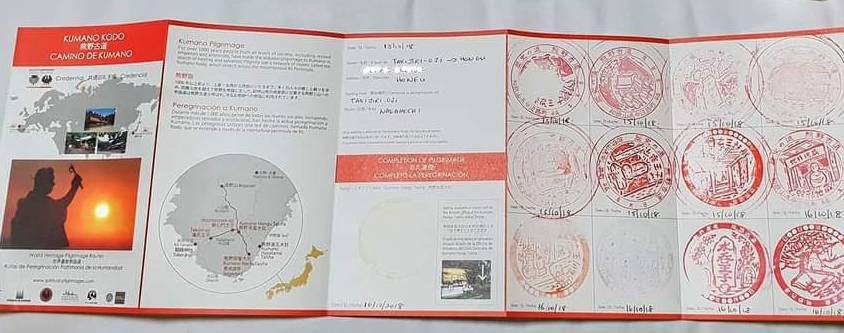Blog home / How To Become A Dual Pilgrim: Camino + Kumano Kodo
Ever heard of the Dual Pilgrim programme? Not many have, but it’s worth exploring—no pun intended!
The Dual Pilgrim programme came about in 2015 when officials in Spain and Japan agreed to “twin” the only two UNESCO-listed pilgrimage routes on earth, the Kumano Kodo Trail in Japan and the Way of St. James (better known as the Camino de Santiago) in Spain.
Recognised by the United Nations as having cultural and natural significance, the two pilgrimage routes offer fascinating and beautiful ways to travel through well-preserved regions in the two nations. The Dual Pilgrim programme was designed to honour and celebrate those who have walked both trails.
HOW TO BECOME A DUAL PILGRIM
To earn a designation as a Dual Pilgrim, you have to walk a significant portion of both routes. You can complete either pilgrimage route first.
For the Camino de Santiago, you need to earn your Compostela (Pilgrims Certificate). That means you must walk at least the last 100 kilometres (Sarria to Santiago) or cycle at least the last 200 kilometres (various options are available) of the Camino de Santiago and that you walk one of four options for the Kumano Kodo pilgrimage.

Three of the four Kumano Kodo options are part of the Nakahechi Route. They include: Takijiri-oji to Kumano Hongu Taisha on foot (~38 km/23 miles), Kumano Nachi Taisha to/from Kumano Hongu Taisha on foot (~30 km/19 miles) or Hosshinmon-oji to Kumano Hongu Taisha on foot (~7 km/4 miles) plus a visit to Kumano Hayatama Taisha and Kumano Nachi Taisha. Or you can walk the Kohechi Route from Koyasan to Hongu (70 km/43 miles).
The ancient Kumano Kodo Trail network is known for its beauty and the deep dive it offers into Japanese culture. The 11th century trail visits the near perfectly preserved three grand Shinto shrines (Kumano Hongu Taisha, Kumano Hayatama Taisha, and Kumano Nachi Taisha) of the Kii Mountains, an area sometimes called the land of the gods. You’ll pass through mountaintop villages, enjoy soothing hot springs, and be left in wonder at sacred temples on this trip through authentic rural Japan.
We offer several beautiful walks that take in portions of the Kumano Kodo Trail.
Meanwhile, the Camino de Santiago is a network of pilgrims trails in mostly northern and western Spain that lead to the shrine of the Apostle Saint James the Great, one of the twelve apostles of Jesus. The various Camino routes pass through quaint Spanish villages and sparkling Spanish countryside.
Our friends at UTracks offer several walking or cycling journeys that take in various portions of the Camino de Santiago.
WHAT TO DO BEFORE YOU BEGIN EITHER PILGRIMAGE
Before you start walking make sure to pick up a Dual Pilgrim Credential, a type of passport for pilgrims.

WHERE TO GET YOUR DUAL PILGRIM CREDENTIAL
On our trips to both the Spanish Camino and Japanese Kumano Kodo pilgrimage routes, you will be provided with your Credential on day 1 of your tour.
If you are walking independently you can obtain your Credential at a local tourist offices or in some cases whatever accommodation you’re using.
More specifically, in Japan the Credential is available at these seven locations:
1. TANABE Tourist Information Center (next to the JR Kii-Tanabe station);
2. Kumano Hongu Heritage Center (near the Kumano Hongu Taisha, Hongu Town, Tanabe City);
3. Kumano Kodo Kan Pilgrimage Center (next to Takijiri-oji, Nakahechi, Tanabe City);
4. Shingu City Tourist Information Center;
5. Nachi-Katsuura Tourism Association tourist information center (next to JR Kii-Katsuura station);
6. Central Information Center, Koyasan Shukubo Temple Lodging Association (near Senjuin-bashi bus stop); and
7. Koyasan Tourist Information Center.
In Spain the Credential is available at tourist offices at the start of each Camino route. They are also available at the end, at the Turismo de Santiago Information Center (near the Santiago Cathedral). The Dual Pilgrim Credential is free of charge.
Along your chosen journey make sure you get your Credential stamped as a record of your pilgrimage. The stamps are reminiscent of country-entry stamps you get in your passport.
There are two sides to the Credential, one for the Kumano Kodo and one for the Camino.
On the Kumano Kodo Trail, the stamps are found in small wooden stands at temple sites along the walk. If the stamp is missing, ask the temple keeper.
On the Camino de Santiago, you can get your Credential stamped by the innkeepers where you stay.
HOW DO I GET MY DUAL PILGRIM CERTIFICATE & BADGE
At the end of the Camino in Santiago, you share your stamp-filled credential with the tourism office and voila—you get a Compostela (pilgrim’s certificate).
The final stamp for the Kumano Kodo is available in the South Hall at the Kumano Hongu Heritage Centre. Here, you’ll also get your certificate.
Now that you have all the necessary stamps, you can register for “Dual Pilgrim” status. You can register after you have completed the second pilgrimage in either Santiago de Compostela (Spain) or Tanabe City (Japan). You’ll receive a nifty badge as well.
For registered Dual Pilgrims completing the Kumano Kodo Trail, the Kumano Hongu Taisha (shrine) has a short “Dual Pilgrim Taiko Ceremony”. This can be arranged at the Kumano Hongu Taisha shrine office. Ceremonies aren’t available on all days.
For Dual Pilgrims that wish to share their experiences, you can ask to be included on the official Dual Pilgrim website.
For more information on either of these special pilgrimages, get in touch with our expert team.